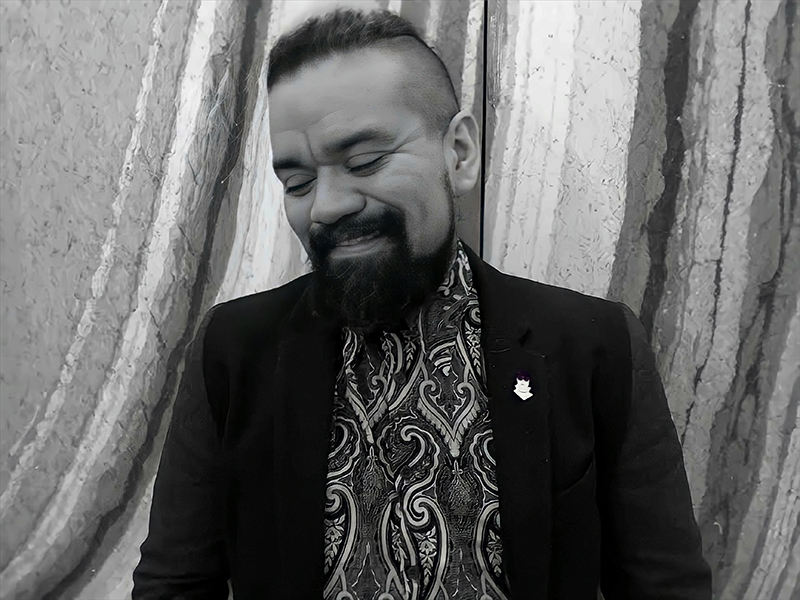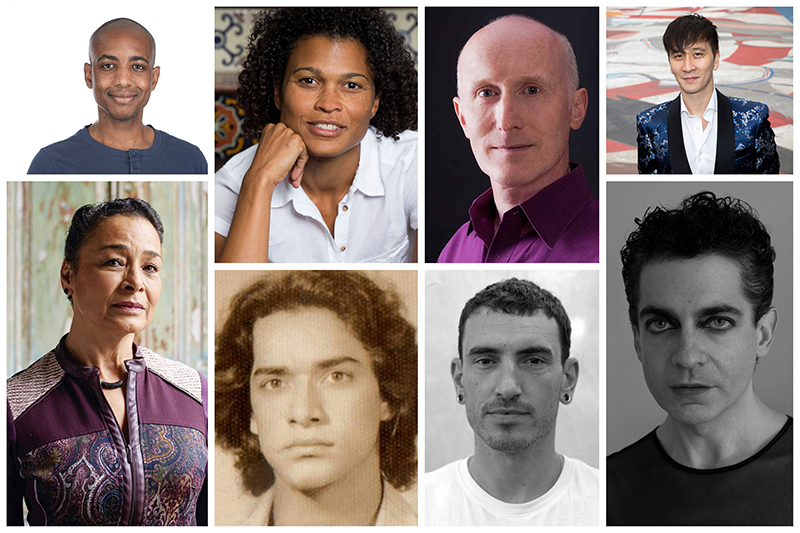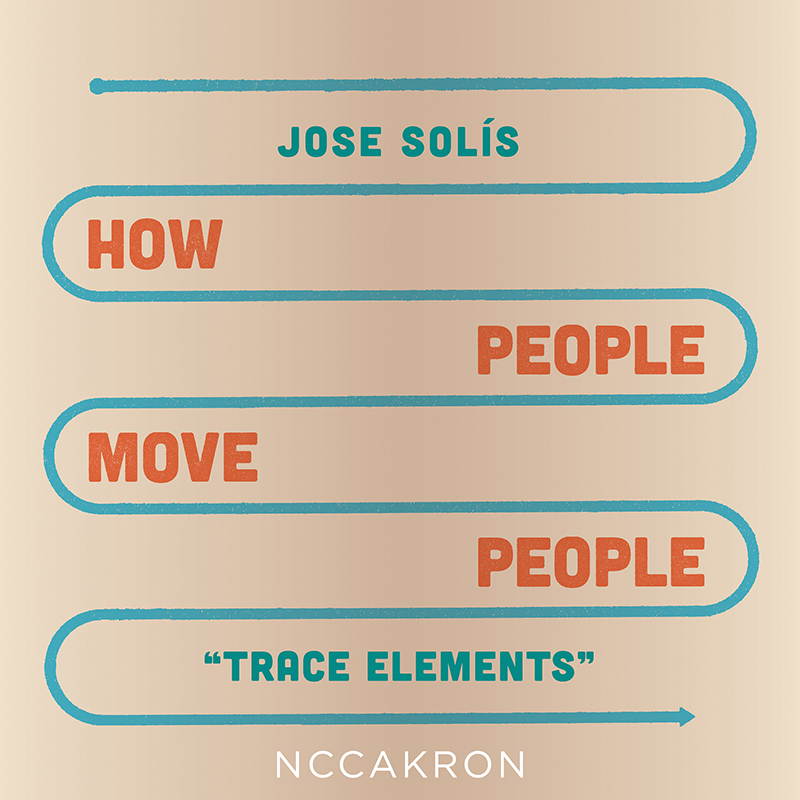Tracing the Impacts of the HIV/AIDS Epidemic
An Interview with Jose Solís
BY EMMALY WIEDERHOLT
The National Center for Choreography – Akron’s (NCCAkron) podcast, How People Move People, looks at the impact that words, art, stories, and lives have on each other. Series Two, titled Trace Elements, was recently released and is hosted by culture critic Jose Solís. It chronicles the legacy and impact of those lost to and living with HIV/AIDS. Jose is originally from Honduras but is currently based in Madrid, Spain. A culture writer and researcher, he traveled through the Americas and Spain, exploring the impact left by dance artists both dead and living who were impacted by the HIV/AIDS epidemic. Stories are honored in the interviewee’s first language, with four episodes in English and three in Spanish. Here, Jose reflects on how the loss of artists to HIV/AIDS continues to reverberate throughout the arts ecosystem, and discusses why telling these stories is still relevant because of the continued assaults on the LGBTQ community.

Jose Solís, photo by Joseph Hernandez
~~
Can you tell me a little about your background and how you connected with NCCAkron?
I’m a culture critic. I’m from Honduras originally, and I started off as a film critic. I wanted to be a film critic since I was 10 years old because film was the most accessible and popular art form I could engage with in my home country. After being in school in Costa Rica, I moved to New York City when I was 26. Going from one of the poorest countries in the world to New York City, in terms of culture, was like a whole new world. I am a culture omnivore. I realized I didn’t have to limit myself to film. I went into theater criticism and journalism. I’ve written pieces on dance, opera, books, you name it. I’ve even written about sports.
NCCAkron got in touch with me. They said they were working on a podcast series and someone had recommended me as a possible researcher who would be interesting to work with. I would need to deliver a podcast in serial form, and I would be working with a producer. The topic was completely up to me. How often do you get the opportunity to get paid to research a topic you choose and an entire professional team to work with? It was a dream come true to be asked to do this.
What was the impetus behind How People Move People: Trace Elements?
First, I am an openly gay man. I came out when I was 18. I grew up in the 90s, so I remember as a child hearing about HIV/AIDS, that it was something deadly. Because I grew up in a very Catholic country, people didn’t talk about HIV/AIDS. But I have an incredible mom. She is a human rights activist and educator. First she started working in schools. Later she did human rights outreach, political empowerment, and HIV/AIDS awareness. She’s 62 and still travels around Honduras to the smallest towns to teach young women about human trafficking.
When I was 17, I decided to drop out of college, and my mom told me that was fine, but I needed a job. I graduated from high school when I was very young at 16. By the time I was about to turn 18, I had done two years of college. I had been studying marketing and communications. My mom pointed me to Foro Nacional de VIH/SIDA, which was the most important NGO in Honduras doing HIV outreach. I started there doing marketing, audio/visual communications, and mini documentaries for social media to educate people about HIV. I fell in love with the work of educating people while educating myself.
HIV has always been surrounded by stigma and ignorance. I’ll never forget when we went to a high school, and in a Q&A a shy young woman asked, “Can I become HIV positive by kissing someone?” The specialist we brought explained that the amount of the virus in saliva was so small that she would have to drink three buckets of a person’s saliva before she could become at risk of being infected. I realized there was power in communication. In addition to that beautiful process of educating, as the only gay man I knew in my home country, I wanted to know more about queer history. A big part of queer history and specifically the history of gay men has to do with HIV/AIDS.
Years later when I lived in New York City and was writing about histories in theater, I started to see how many people had died during the AIDS epidemic. I was so shocked and sad by the fact that we lost all these artists who could have had a different path or been role models. I wondered what happened to their stories. Thinking specifically about theater, I asked my colleague Peter Filichia who is an incredible theater historian if he knew of a book of all the artists who died during the AIDS epidemic. Peter told me that book doesn’t exist, so it was up to me to write it. I never got around to writing that book, but that idea of what happened to those people, how we commemorate and celebrate people, stayed with me.
When the COVID pandemic started, the idea of loss became present for all of us. We were grieving people who were here one day and dead two weeks later. I lost colleagues. People I knew professionally vanished. When NCCAkron asked me what I wanted to do for this podcast, I immediately knew I wanted to explore this idea of what HIV/AIDS’ impact had been.
I understand you don’t have a history in dance. Why were you interested in covering the impact of the HIV/AIDS epidemic through the lens of dance artists?
Something I love about dance is there’s this elusiveness. Some critics say they don’t know how to write about or react to dance. When writing about dance, I don’t think what’s important is the technique; I think what’s important is the energy. I saw Swan Lake a couple weeks ago. When Odette leaps toward her death, what happens on a molecular level? It made me think about what happened to the energy of all these incredible dancers and choreographers I never would meet because they died of AIDS. I’m not trying to ascribe a spiritual meaning to this, but if we are made of molecules, something must have happened to those molecules’ energy. They meant something to the audience, to their family members, to researchers, to whomever encountered their work on YouTube or read their obituary. I wanted to make sure they were remembered.
How did you choose your interview subjects?
One of my problems as a human being is I want to do too much at the same time. My producer Jennifer Edwards helped me narrow my ideas down. Originally, I was going to focus on New York City. But as someone who is a migrant and who has travelled the world looking for home, I realized New York City is not the center of the universe. I wanted to honor people from different places in addition to New York City. What about the stories from my hometown or San José, Costa Rica? The podcast became a travel log, an autobiography of the places I’ve lived and existed. I wanted to find that missing energy of those artists who died from AIDS in those places. I ended up narrowing down what that could look like. Did I want to find people’s families, colleagues, or students? I narrowed until I found the perfect person to interview in each place.
Those people are: Jack Ferver in New York City, Jose Zambrano in Tegucigalpa, Honduras, Phil Chan in Brooklyn and Graham Lustig in Oakland, Aimar Perez Gali in Barcelona, Spain, Rosalynde LeBlanc in Los Angeles, Nandayure Harley in San José, Costa Rica, and Juan Michael Porter II in New York City. There are seven episodes.

Pictured clockwise: Juan Michael Porter II, photo courtesy of artist; Rosalynde LeBlanc, photo by Eric Politzer; Graham Lustig, photo courtesy of artist; Phil Chan, photo by Eli Schmidt; Jack Ferver, photo by Jeremy Jacob; Aimar Pérez Galí, photo by Shadha Agliata; José Zambrano, photo courtesy of artist; Nandayure Harley, photo courtesy of artist
The podcasts are released in the interviewee’s native language, so there are four in English and three in Spanish. How has having the podcast be in two languages affected listenership?
As a critic and someone who still works mainly for US publications, I’ve always commented on the lack of representation of other languages, specifically Spanish. I cannot think of a film or theater critic who works in Spanish. If I was going to go to Spanish-speaking places and interview artists, I wanted it to be in their language. I was really lucky that NCCAkron loved the idea for some of the podcasts to be in English and some in Spanish.
I knew it was going to limit who could listen. But I wanted to offer something to people who don’t usually have access to criticism and arts journalism. I’m thinking specifically about the person I interviewed in my home country, Jose Zambrano. This is someone who has been doing outreach around HIV/AIDS for the LGBTQ community for 40 years. This is someone who has won awards from international NGOs. I didn’t want to not include this person because they don’t fit into the English system.
On a more personal level, my mom, who is responsible for so much of who I am, does not speak English and has historically not been able to access my work. I wanted the project to be a love letter to my mom. I wanted her to be able to listen to my work. I wanted to honor what she does.
The height of the AIDS/HIV epidemic happened more than 30 years ago. Why is it important to revisit the epidemic and its impact now?
One of my friends and interviewees for the podcast, Juan Michael Porter II, in addition to being a beautiful dancer and choreographer, is a theater critic and editor. He pointed out to me that it took less than a year to develop the COVID vaccine, but 40 years after the first case of HIV, there’s still no vaccine for AIDS. It speaks to how the queer community has been constantly discriminated against. Unfortunately, HIV/AIDS still exists. In 2016, one in 11 white gay men became HIV positive, one in four Latino gay men became HIV positive, and for Black gay men, it was one in two.
PrEP (short for Pre-Exposure Prophylaxis) is a pill that people who are HIV negative can take, and it reduces the risk of becoming HIV positive. This is a pill that should be free and available all over the world. Sub Saharan Africa and Latin America are still experiencing the ravages of AIDS. PrEP is something doctors should talk to people about whether or not they are gay.
I’m not a health practitioner, but I think of Trace Elements as a form of outreach. In the episode I did with Nandayure Harley, the Costa Rican choreographer, I ended up talking to her about PrEP because she hadn’t heard about it. If someone goes into this podcast thinking they want to hear about dance and they learn about PrEP, my job is done.
What do you hope listeners take away?
I want people to know that there always will be someone who remembers them and that their legacy, whether or not they are famous, meant something. In my home country of Honduras, there’s not really a dance culture like in New York City. When I interviewed Jose Zambrano, I had to figure out how to talk about dance and choreography in a place where it doesn’t really exist. That episode is about the trans women who did sex work and exotic dancing in my hometown, Tegucigalpa. He shared with me stories about women who are not in books or documentaries, but now they get to live on. In some point in history, there was a trans woman in Honduras who loved dancing to Donna Summer and early Madonna and fashioned her entire look based on Madonna. That woman existed, and now people know about her.
~~
To listen to the podcast How People Move People: Trace Elements, visit www.nccakron.org/howpeoplemovepeople.

Artwork by Micah Kraus
